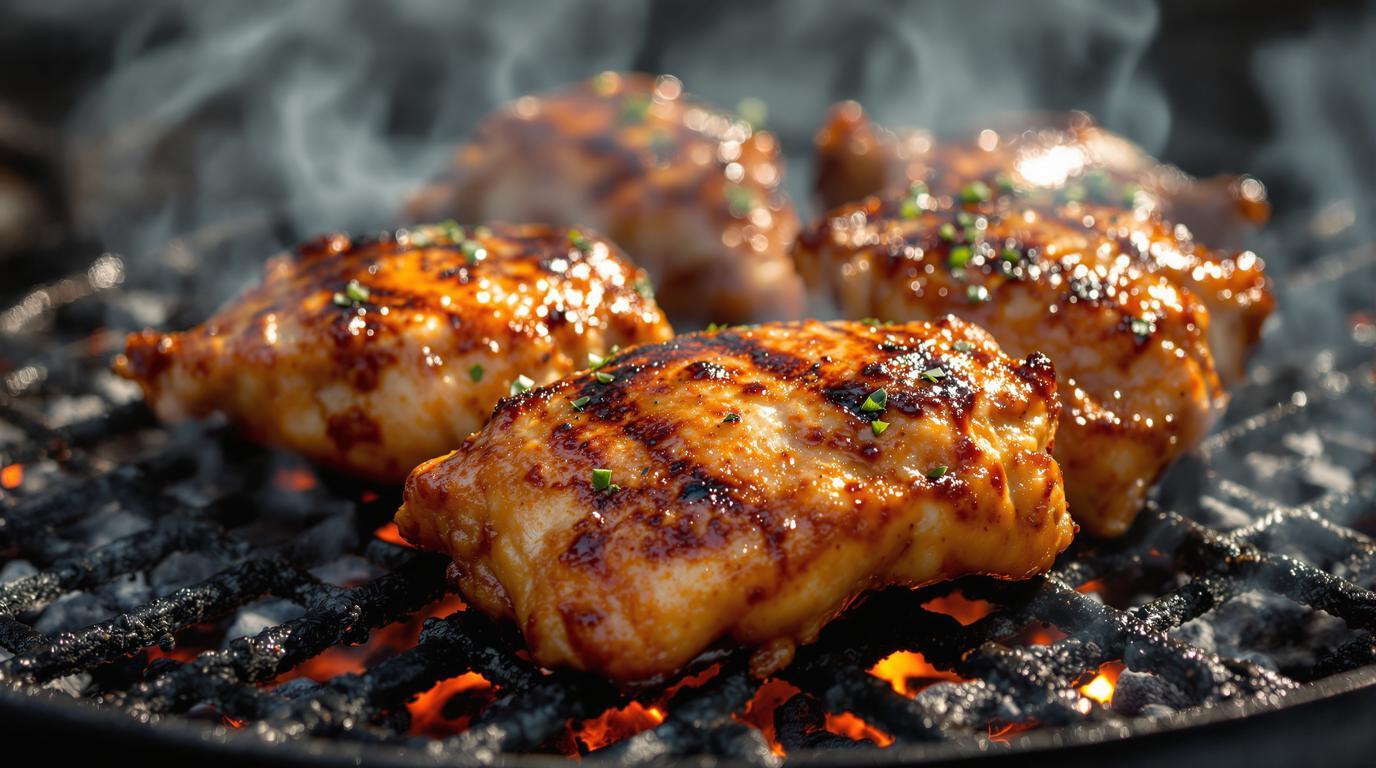The first time I made Cornell Chicken was during a family reunion in upstate New York. My great-uncle, who’d been grilling this regional specialty since the 1950s, stood beside me as we whisked the simple marinade together. “This recipe came from Cornell University’s farm cooperative program,” he explained, passing down what would become my summer grilling signature. “They created it to help poultry farmers sell more chicken, but what they accidentally created was culinary magic.” The tangy, savory marinade with its secret egg emulsion creates chicken that’s crisp outside, incredibly juicy inside, and unforgettable for anyone lucky enough to try it. 🍗
The Story Behind Cornell Chicken 📖
This marinade isn’t just delicious—it’s a piece of American culinary history. Developed in the 1940s by Professor Robert Baker at Cornell University’s Agricultural School, this recipe was designed to promote chicken consumption among New York farmers. What began as a practical solution became a regional treasure that families have passed down for generations. Unlike fancier marinades with long ingredient lists, Cornell Chicken relies on humble pantry staples combined in perfect balance—proving that sometimes, grandmother’s simple recipes truly are best. 🏆
The magic lies in the egg-oil emulsion, a technique that predates modern cooking science but intuitively creates a coating that locks moisture inside while developing incredible flavor and browning on the grill. This summer, professional chefs and home cooks alike are rediscovering this treasure, with variations popping up on restaurant menus nationwide.
Essential Ingredients 🧾
The beauty of Cornell Chicken marinade is its simplicity:
- 1 large egg (room temperature works best)
- 1 cup (240ml) vegetable oil
- 2 cups (480ml) apple cider vinegar
- 3 tablespoons (45g) kosher salt
- 1 tablespoon (8g) poultry seasoning
- 1 teaspoon (2g) freshly ground black pepper
This makes enough marinade for about 5 pounds (2.3kg) of chicken—perfect for a family gathering. I prefer bone-in, skin-on chicken pieces for the juiciest results, though boneless works beautifully too.
Step-by-Step Instructions 📝
The technique is straightforward but requires attention to detail:
- In a large bowl, beat the egg until fully blended.
- Slowly drizzle in the oil while whisking constantly—this creates a stable emulsion similar to mayonnaise. 💡
- Gradually add the vinegar while continuing to whisk.
- Stir in salt, poultry seasoning, and pepper until fully incorporated.
- Place chicken pieces in a large zip-top bag or shallow glass baking dish.
- Pour marinade over chicken, ensuring all pieces are fully submerged.
- Refrigerate for 6-8 hours (overnight is fine, but not longer than 24 hours).
- Remove chicken from marinade, allowing excess to drip off. Pat lightly with paper towels.
- Grill over medium heat (about 350°F/175°C), turning occasionally, until internal temperature reaches 165°F (74°C)—about 40-45 minutes for bone-in pieces.
- Let rest 5-10 minutes before serving.
Chef’s Note: The egg in this marinade serves two critical purposes—it creates an emulsion that helps oil and vinegar bind together, and it forms a subtle coating that helps seasonings adhere to the chicken while promoting beautiful browning. Don’t skip this essential ingredient!
Chef’s Secret Techniques 🤫
For truly exceptional Cornell Chicken, I’ve discovered a few professional tricks:
First, maintain a moderate grill temperature. Too hot, and the marinade’s sugars will burn before the chicken cooks through. I keep one side of my grill medium-hot and the other medium-low, starting skin-side down on the hotter side to get good marking and color, then moving to the cooler side to finish cooking gently.
Second, baste occasionally with reserved marinade that you’ve boiled for 5 minutes (to eliminate raw egg concerns). This builds layers of flavor similar to classic vinaigrettes and creates a gorgeous lacquered finish. 🔥
If you can’t find poultry seasoning, create your own with 2 parts dried sage, 1 part dried thyme, 1 part dried rosemary, and 1 part dried marjoram. The herbaceous quality complements the vinegar’s tang perfectly.
Serving & Presentation Tips 🍽️
Cornell Chicken pairs beautifully with summer classics. My favorite combination includes a simple potato salad, buttered corn on the cob, and a crisp coleslaw. The vinegary tang of the chicken complements these creamy, sweet sides perfectly. For a special touch, try serving alongside a Peach Caprese Salad for a sophisticated twist.
For wine pairings, I recommend a crisp, unoaked Chardonnay or Sauvignon Blanc to complement the tangy profile. Beer lovers will appreciate a wheat beer or light lager.
This recipe also makes spectacular leftovers—shred the chicken for incredible sandwiches or toss with greens for a protein-packed salad. For a quick breakfast option, combine leftover chicken with eggs and vegetables in a hearty scramble, similar to my protein-packed breakfast recipes.
Whether you’re hosting a backyard gathering or preparing a simple family dinner, Cornell Chicken delivers exceptional flavor with minimal effort. As I tell my culinary students, sometimes the most remarkable dishes come from the simplest techniques—this grandmother-approved classic certainly proves that point. Your guests will be copying this recipe all summer long! 👨🍳
